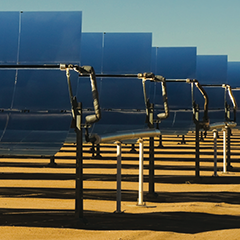A sector of the solar market that is expected to grow from two to four gigawatts per year, CSP is currently enjoying an enviable boom. But it’s worth noting that the technology relies on a seemingly innocuous small part to work effectively, as Janaki Weiden, Global Market Manager, Saint-Gobain Performance Plastics, explains.
The facts speak for themselves – solar energy is a huge and important trend. Solar energy is infinite and free, with the total amount of energy irradiated from the sun to the earth’s surface each year providing enough for annual global consumption 10,000 times over. The benefits of solar power are both compelling and obvious, from reducing carbon emissions to providing a sustainable energy source.
Solar energy is a completely renewable resource as we can always rely on the sun showing up tomorrow as a consistent power source. Alternatively, the majority of energy sources that are currently used to power buildings, such as oil, gas and electricity, are predominantly non-renewable resources. Once depleted, they are gone forever. If we are solely reliant on these sources, we will no longer have power or energy. It is therefore vital that the solar power trend continues to grow.
Recognising the importance of the solar power trend, the European Union has committed to making 20 per cent of energy renewable by 2020. It is essential that technologies employed by Concentrated Solar Power (CSP) plants are of the highest standard to reach this goal. The United Nations Framework Convention on Climate Change (UNFCCC), which entered into force in 1994, is made up of 192 countries committed to affecting climate change. The UNFCCC treaty was born to exchange information and offer support related to climate change, and to develop strategies aimed to reduce greenhouse gas emissions.
In 1997, an addition to the treaty, the Kyoto Protocol, was adopted by 184 countries. The Kyoto Protocol, which entered into force in 2005, sets targets for various countries and the European community for reducing greenhouse gas emissions by an average of 5 per cent against 1990 levels from 2008-2012. And these regulations are another driving force behind the growth in demand for solar energy.
So what makes the huge solar power trend work? Small parts, of course. It is predicted that in a few years, the CSP market will grow from two to four gigawatts per year. To meet the on-going demand for energy, it is crucial to continually enhance the longevity of the CSP plant. The small parts that make up these large plants help to keep the applications maintenance free, long lasting, and moving efficiently, extending overall facility life and productivity.




























